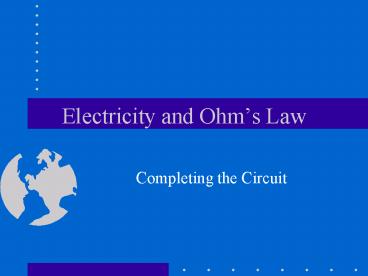Electricity and Ohms Law - PowerPoint PPT Presentation
1 / 16
Title:
Electricity and Ohms Law
Description:
Electromagnetism is the scientific study of electric charges ... In a household electric outlet, the potential difference (voltage) between the ... – PowerPoint PPT presentation
Number of Views:205
Avg rating:3.0/5.0
Title: Electricity and Ohms Law
1
Electricity and Ohms Law
- Completing the Circuit
2
What is Electricity?
- Common definitions
- The power used to run electric devices
- Anything having to with electric power
- Electromagnetism is the scientific study of
electric charges - All electrical phenomenon are caused by electric
charges, usually tiny particles called electrons
3
Electric Charge
- Electrons have a negative electric charge
- An object can have three types of electric charge
- Negative lots of extra electrons
- Neutral just the right amount of electrons
- Positive not enough electrons
- Alike charges repel, opposite charges attract
4
Conductors and Insulators
- In a conductor, electrons can move freely through
the material - Examples
- Most metals (copper, silver and gold are some of
the best conductors) - Salt water
- In an insulator, electrons have difficulty moving
through the material - Examples
- Most plastics and ceramics
- Distilled water
- Air
5
Electric Current
- The flow of electrons is called electric current
- The unit of electric current is the ampere or amp
for short - The symbol for amp is A
- An amp is the measure of how much charge flows by
per second
6
Potential Difference (Voltage)
- A potential difference occurs when there are more
electric charges in one location than in another - The unit of potential difference is a volt
- The symbol for volt is V
- Example excess electrons will be attracted to
the positive plate because of the potential
difference
e-
- - - - - - - - - - - - - - - - - - -
7
A More Relevant Example
- In a household electric outlet, the potential
difference (voltage) between the two slots is 120
volts - Because of a power plant many miles away,
electrons are under pressure to move from one
slot to the next
8
Electrical Circuits
- An electrical circuit is formed when electrons
are given a path to move across a potential
difference - Generally, conducting (metal) wires are used to
complete the circuit
9
Electrical Resistance
- Electrical resistance is the measure of the
resistance of part of a circuit to the flow of
electricity (current) - Electrical resistance is measured in ohms
- Ohms are often represented by the symbol omega
(?) - Example the filament of a 100 W lightbulb
presents a resistance of about 140 ? to the flow
of electricity
10
The Water Pressure Model
- A helpful way of thinking about current, voltage
and resistance is to compare electricity to the
flow of water - voltage (i.e. potential difference) is analogous
to the water pressure - current is analogous to the flow of water
- resistance is analogous to the diameter of the
pipe (e.g. a small pipe allows much less water to
flow than a large pipe)
11
Ohms Law
- Voltage, current and resistance in an electric
circuit can be related using Ohms Law - Ohms law states that
- V I x R
- where
- V is the voltage (in volts)
- I is the current (in amps)
- R is the resistance (in ohms)
12
Example 1
- If 4 amps of current are flowing through a
toaster connected to a 120 V outlet, what is the
resistance of the toaster? - Answer Rearrange V I x R to get R V/I
- Thus, R (120 V)/(4 A) 30 ?
13
Example 2
- If a lightbulb connected to an outlet has a
resistance of 144 ?, what current is flowing
through the bulb? - Answer Rearrange V I x R to get I V/R
- Thus,
- I (120 V)/(144 ?)
- 0.83 A
14
Home Wiring Parallel Circuits
- A single switch can be used to turn on multiple
lights or appliances if they are connected in
parallel - The voltage is the same for each light or
appliance, although the current increases with
each new addition - A fuse is designed to break if the current gets
too large
Fuse
Voltage
Lights
Switch
15
Home Wiring Series Circuits
- If a lights or appliances are connected in series
they will not experience the same voltage - Since most lights and appliances are designed to
work at a specific voltage, they cannot be
connected in series - The resistance of lights or appliances connected
in series is the sum of their resistances
Fuse
Voltage
Lights
Switch
16
Example
- What is the total resistance of three 100 W light
bulbs (each 144 ?) in series? - Answer 144 144 432 ?
- What is the total current through three 100 W
light bulbs? - Answer I (120 V)/(432 ?) 0.27 A
- Note this is significantly less than the 0.83 A
that will flow through a single bulb (i.e. the
bulbs will be dimmer)














![L 26 Electricity and Magnetism [3] PowerPoint PPT Presentation](https://s3.amazonaws.com/images.powershow.com/6814856.th0.jpg?_=20150627027)
















